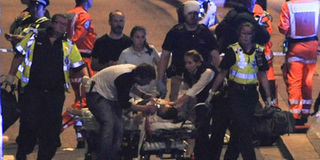Terrorism is evolving and the world must move fast to catch up or perish

Police and members of the emergency services attend to victims of a terror attack on London Bridge in central London on June 3, 2017. PHOTO | DANIEL SORABJI | AFP
What you need to know:
- In 1988, Pan-Am flight 103 crashed in the Scottish village of Lockerbie when a bomb placed on board the aircraft exploded.
Stepping onto the tarmac to cross the road is now a terrifying experience as you could get mowed down by a supporter of ISIS.
Growing up, what was your definition of terrorism? In the colonial era, national liberation movements that fought against colonialism and sought the independence of their countries were deemed to be terrorists.
This is despite their very legitimate actions to fight against the colonial rulers. Indeed, ‘one person’s terrorist is another person’s freedom fighter’.
So misconstrued was the branding of freedom fighters as terrorists that the 1993 Nobel Peace Prize Laurate Nelson Mandela was on the USA terror list until 2008.
Later on, the 1970s saw the rise of hostage taking and mass shootings. In the 1972 Munich Summer Olympics, 11 Israeli Olympians were taken hostage and killed by the Palestinian terrorist group called Black September. Closer to home, Operation Entebbe unfolded in Uganda in 1976 when an Air France plan destined for Paris was hijacked and grounded.
FLIGHT PASSENGER
Then came the 1980s, arguably the most terrifying decade to be a flight passenger. In 1988, Pan-Am flight 103 crashed in the Scottish village of Lockerbie when a bomb placed on board the aircraft exploded.
259 passengers on board and 11 persons on the ground were killed. The next year, French UTA flight 772 crashed in the Niger after a device on board the aircraft exploded. 171 people died.
If we thought we were so far removed, on August 7, 1998, the USA embassy in Nairobi was bombed, and 207 of our fellow citizens lost their lives.
The subsequent days and nights were horrifying. For days, we stayed glued to our screens and the analogue radio following up on the rescue mission, waiting for confirmation of our attacker. Then the news cycle came, and with it carried the name Osama bin Laden.
Three years later, the world came to clear grips with who Osama bin Laden was. On September 11, 2011, four US passenger planes were hijacked by Al-Qaeda.
WORLD TRADE CENTRE
Two of those crushed into the World Trade Centre, one into the Pentagon and the last one crashing near Shanksville, Pennsylvania. 2,977 people died.
Every generation has faced a new wave of terrorism. In the wake of Bin Laden’s death in 2011, terrorism has now morphed into small regional non-state military organisations.
ISIS is causing havoc in Europe, while Al-Shabaab is terrifying us out of own homes, schools, workplaces, and markets. It is no longer about large-scale operations with a high death toll. We now predominantly face the lone terrorist.
Stepping onto the tarmac to cross the road is now a terrifying experience as you could get mowed down by a supporter of ISIS.
No longer can you sit blissfully unaware in a concert, hotel or public place. The worst thing is, you cannot profile the lone terrorist to quickly alert the authorities.
He could be anyone. Even the most highly resourced country will struggle to accurately identify and subsequently keep a 24/7 surveillance on a potential terrorist.
TERRORISTS
The reality, is some individual terrorists will not be picked up on any radar and will, unfortunately, be successful in their abhorrent attack. Karst Tates drove his car into a crowd during the Dutch Queensday celebrations in 2009. Until today, his motives are unknown.
Lastly, the lone terrorist inspires copy cats. In December 2016, a van drove into a market in Berlin killing 12 people. In August this year, a van drove into a crowd in Barcelona leaving 13 dead.
Despite decades of terrorist attacks and countries standing in solidarity with the attacked State, there is still no universally agreed definition of terrorism or a primary international counter-terrorism convention. Is it bombings? Hijackings? Mass shootings? Or mowing down pedestrians?
DEATH
The closest definition of terrorism is any act intended to cause death or serious bodily injury to a civilian with the purpose of intimidating a population, or to compel a government or an international organisation to do or to abstain from doing any act.
The nature of terrorism is evolving. It is time the International Community agreed on a definition.
This article was compiled with the help of a clinical pharmacist. The writer works with international businesses on commercial litigation. [email protected]





